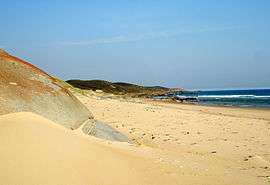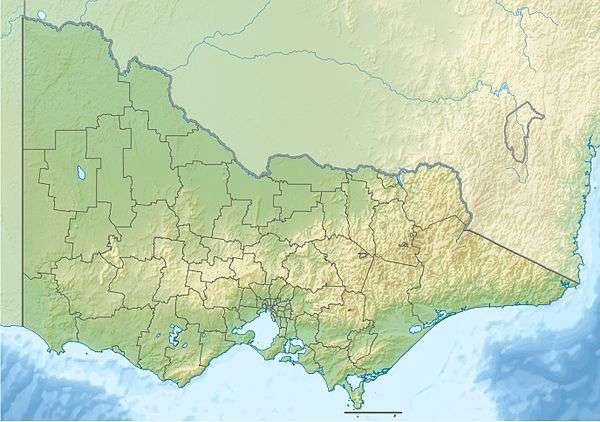Croajingolong National Park
The Croajingolong National Park is a coastal national park located in the East Gippsland region of the Australian state of Victoria. The 88,355-hectare (218,330-acre) national park is situated approximately 450 kilometres (280 mi) east of Melbourne and 500 kilometres (310 mi) south of Sydney.
| Croajingolong National Park Victoria | |
|---|---|
IUCN category II (national park) | |
 A beach in the Croajingolong National Park; looking north towards Rame Head. | |
 Croajingolong National Park | |
| Nearest town or city | Mallacoota |
| Coordinates | 37°42′43″S 149°30′30″E |
| Established | 26 April 1979[1] |
| Area | 883.55 km2 (341.1 sq mi)[2] |
| Managing authorities | Parks Victoria |
| Website | Croajingolong National Park |
| See also | Protected areas of Victoria |
The name Croajingolong derives from the Australian Aboriginal Krauatungalung words galung, meaning "belonging to" and kraua, meaning "east".[3]
Location and features
The park is linear in shape and bordered on the southern side by the Tasman Sea of the South Pacific Ocean, the western side by Bemm River and the eastern side by the township of Mallacoota. Its northern boundary consists of dense bushland and low hills. The dimensions of the park are approximately 80 kilometres (50 mi) by 20 kilometres (12 mi), with an area of 875 square kilometres (338 sq mi). The 100 kilometres (62 mi) Wilderness Coast Walk stretches the entire length of the park along beaches, through heathland and round rocky headlands.
Croajingolong National Park, with the adjoining Nadgee Nature Reserve in New South Wales, forms one of only twelve World Biosphere areas in Australia.[4] It contains ecosystems, habitats and gene pools that are managed sustainably. The park encloses the Sandpatch Wilderness Area and is contiguous with the Cape Howe Wilderness Area, the Nadgee Nature Reserve and the Cape Howe Marine National Park.
Important Bird Area
The eastern section of the park lies within the Nadgee to Mallacoota Inlet Important Bird Area, so identified by BirdLife International because it supports populations of eastern bristlebirds and pilotbirds as well as other significant fauna.[5]
Visitor attractions
Croajingolong's landscapes are so spectacular and environmentally significant that the United Nations Educational, Scientific and Cultural Organisation (UNESCO) nominated it a World Biosphere Reserve in 1977.[6] The park houses impressive biodiversity, including almost 1,000 native plant species and 315 animal species.
The diverse coastal landscapes feature rocky outcrops, large stretches of sandy beaches, coastal dunes and freshwater rivers, making the park a popular destination for hiking and walking, swimming, diving, snorkelling and sea kayaking.
A popular way to explore the remote wilderness and diverse flora and fauna of the national park is on the Wilderness Coast Walk, which extends 45 kilometres from Thurra River camping area to Shipwreck Creek.
Popular destinations within the park include:
- Point Hicks and its lighthouse
- Tamboon Inlet resort town
- Spectacular sand dunes at Thurra River
- Lake Elusive near Wingan Inlet
- Mount Everard
- Rame Head
Camping spots exist at Wingan Inlet, Shipwreck Creek and Peachtree Creek and are all accessible by car. The camp sites at Mueller Inlet and Thurra River are privately managed. Most campgrounds are equipped with picnic facilities and fireplaces.[7]
Nearby towns are Mallacoota, Genoa, Cann River, Bemm River and Orbost.
See also
- Protected areas of Victoria (Australia)
- List of biosphere reserves in Australia
References
- Croajingolong National Park Management Plan (PDF). Department of Natural Resources and Environment (PDF). Government of Victoria. June 1996. ISBN 0-7306-6137-7. Archived from the original (PDF) on 14 August 2014. Retrieved 11 August 2014.
- "Croajingolong National Park: Visitor Guide" (PDF). Parks Victoria (PDF). Government of Victoria. July 2014. Archived from the original (PDF) on 21 September 2015. Retrieved 11 August 2014.
- "Croajingolong (county): Historical information: 30383". Vicnames. 12 August 2011. Archived from the original on 12 August 2014. Retrieved 11 August 2014.
- "Australia's Biosphere Reserves". Department of Sustainability. Australian Government. Archived from the original on 19 November 2008. Retrieved 8 May 2011.
- "IBA: Nadgee to Mallacoota Inlet". Birdata. Birds Australia. Archived from the original on 6 July 2011. Retrieved 27 August 2011.
- "UNESCO - MAB Biosphere Reserves Directory". www.unesco.org. Retrieved 20 June 2015.
- "Parks Victoria - Camping at Croajingolong". parkweb.vic.gov.au. Retrieved 20 June 2015.
External links
| Wikimedia Commons has media related to Croajingolong National Park. |
- Croajingolong National Park page, at Parks Victoria
- Wilderness Coast Walk
- Hand made artist's book of etchings inspired by a bushwalk in Croajingolong National Park. Book created by Sandi Rigby and copy no.5 held by the Australian Library of Art, State Library of Queensland
- Croajingolong featured in the song Croa-jingo-long by Harold Williams (as Geoffrey Spencer) in 1923.